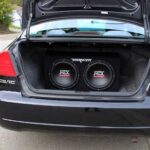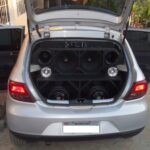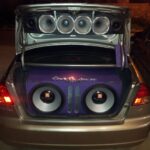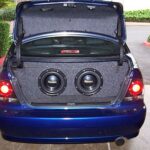How Subwoofer Works | Unleashing Powerful Bass (h1)
A subwoofer works by using a large driver and a powerful amplifier to reproduce low-frequency sounds precisely and accurately. The driver in a specially designed enclosure moves rapidly to generate sound waves at specific frequencies.
(This Portion is for Feature Snippet)
Subwoofers enhance audio systems by delivering deep bass responses and rumbling sound effects. This key component adds richness and depth to music, movies, and other audio experiences. Adding a subwoofer to your system can greatly enhance the overall audio quality by providing a more immersive listening experience.
The precise reproduction of low-frequency sounds by a subwoofer adds depth and richness to music, movies, and games. Whether you are a music enthusiast, a movie buff, or an avid gamer, a subwoofer is a crucial element in creating a well-rounded audio setup. By understanding how a subwoofer works, you can make an informed decision on incorporating this essential component into your audio system.
Components Of a Subwoofer (h2)
Understanding the components that make up a subwoofer is essential for appreciating how it functions. Each element plays a crucial role in delivering the deep, low-frequency sounds that have become synonymous with high-quality audio. Let’s delve into the key components of a subwoofer to gain a better understanding of its inner workings.
Amplifier (h3)
An amplifier is an integral part of a subwoofer system, responsible for powering the speaker and delivering the necessary energy to produce low-frequency sounds. It takes the audio input signal and amplifies it to drive the speaker, ensuring that the subwoofer can accurately reproduce deep bass tones with precision and clarity.
Speaker Cone (h3)
The speaker cone is a vital component that directly translates electrical signals into physical vibrations, ultimately generating sound waves. Typically made from durable materials such as paper, plastic, or composite fibers, the cone moves back and forth rapidly in response to the amplified signal, creating the low-frequency audio waves that are characteristic of the subwoofer’s performance.
Enclosure (h3)
The enclosure, or cabinet, of a subwoofer is specially designed to house the speaker components in a way that maximizes sound quality and efficiency. It plays a crucial role in controlling the movement of air around the speaker and helps to minimize unwanted resonances and distortions. The type of enclosure, whether sealed or ported, also greatly influences the overall sound characteristics produced by the subwoofer.
How Subwoofers Produce Low Frequencies (h2)
Subwoofers work by using a large driver and a powerful amplifier to reproduce low-frequency sounds with precision and accuracy. The driver, typically housed in a specially designed enclosure, moves back and forth rapidly to generate sound waves at specific frequencies.
The Role of The Amplifier (h3)
The amplifier plays a crucial role in powering the subwoofer and ensuring that it can produce deep, impactful bass. It receives the audio signal from the main audio source and increases its power, allowing the subwoofer to produce low frequencies with clarity and depth.
The Role of The Speaker Cone (h3)
The speaker cone, also known as the driver, is responsible for converting the amplified audio signal from the amplifier into physical movement. The cone’s rapid back-and-forth motion pushes and pulls the air, creating low-frequency sound waves that add richness and depth to the audio experience.
The Role of The Enclosure (h3)
The enclosure, or cabinet, of the subwoofer is designed to help control the movement of the speaker cone and enhance the overall sound output. It provides a stable environment for the driver to operate, prevents sound waves from canceling each other out, and maximizes the efficiency of the subwoofer’s performance.
Different Types of Subwoofer Designs (h2)
A subwoofer is an important component of any audio system. It is specifically designed to reproduce low-frequency sounds, such as bass and sub-bass frequencies, with precision and accuracy. Subwoofers work by using a large driver and a powerful amplifier to generate sound waves at specific frequencies. There are different types of subwoofers designs available, each with its own unique characteristics and advantages.
Ported Subwoofers (h3)
A ported subwoofer, also known as a bass reflex subwoofer, is a popular choice for many audio enthusiasts. It features a port or vent in the enclosure that allows the air to flow in and out, enhancing the bass response. The ported design increases the efficiency of the subwoofer, allowing it to produce louder and deeper bass compared to other designs. Ported subwoofers are ideal for music enthusiasts who crave powerful and impactful bass.
Sealed Subwoofers (h3)
A sealed subwoofer, also known as an acoustic suspension subwoofer, is designed with a sealed enclosure that does not have any ports or vents. This design provides tight and accurate bass reproduction. Sealed subwoofers are known for their precise and controlled bass response, making them suitable for audiophiles who prefer accurate and balanced sound reproduction. These subwoofers are commonly used in music studios and home theater systems.
Bandpass Subwoofers(h3)
Bandpass subwoofers are designed with a dual-chamber enclosure that utilizes both the sealed and ported designs. These subwoofers offer a combination of the advantages of both sealed and ported enclosures. The rear chamber of the subwoofer is sealed, while the front chamber is ported. This design allows for enhanced efficiency and increased bass output. Bandpass subwoofers are known for their high output levels and are often used in car audio systems.
Placement Of Subwoofers (h2)
When setting up your audio system, the placement of your subwoofers plays a crucial role in achieving optimal sound quality and bass performance. Here, we’ll discuss two key aspects of subwoofer placement that you need to consider: Optimal Room Positioning and Correct Distance from Other Speakers.
Optimal Room Positioning (h3)
The position of your subwoofers within the room can greatly impact the sound they produce. To maximize bass response and eliminate unwanted resonances, follow these guidelines:
- Place the subwoofers along the front wall or in the corners of the room. These locations help distribute low-frequency sound evenly throughout the space.
- Avoid placing the subwoofers too close to walls or corners, as this can result in excessive bass buildup and make the sound boomy.
- Experiment with different placements to find the spot that provides the best balance of bass extension and smoothness.
Correct Distance from Other Speakers (h3)
The distance between your subwoofers and other speakers in the system is essential to ensure a seamless integration of sound. Follow these recommendations:
- Position the subwoofers equidistant from the main speakers. Aim for symmetry to maintain a cohesive soundstage.
- Keep the subwoofers at a reasonable distance from the main listening area. This helps prevent localization of bass and ensures a consistent listening experience.
- If using multiple subwoofers, space them apart to reduce the chances of cancellation or reinforcement of certain frequencies.
By considering both optimal rooms positioning and the correct distance from other speakers, you can enhance the overall performance and enjoyment of your subwoofers. Take the time to experiment and fine-tune these factors to achieve the best possible bass reproduction in your audio setup.
Common Subwoofer Setup Mistakes (h2)
When setting up a subwoofer, there are several common mistakes to avoid to ensure optimal performance and sound quality. These errors can result in an improper balance of sound frequencies and may lead to distortion or inefficiency of the subwoofer. Understanding and rectifying these mistakes can vastly improve the overall audio experience.
Improper Calibration (h3)
Incorrect calibration of a subwoofer can lead to an imbalance in the sound output, resulting in either overpowering or underwhelming bass. This can occur due to incorrect settings of volume, crossover frequency, or phase. One must carefully adjust these settings to ensure a seamless integration of the subwoofer with the main speakers.
Inadequate Power Supply (h3)
A common mistake is not providing the subwoofer with adequate power. Insufficient power can result in a lack of depth and impact in the bass, diminishing the overall audio quality. It’s crucial to ensure that the subwoofer receives the necessary power output to deliver a balanced and powerful low-frequency response.
Incorrect Phase Alignment (h3)
Improper phase alignment of the subwoofer with the main speakers can cause cancellation or reinforcement of certain frequencies, leading to an uneven bass response. Aligning the phase correctly ensures that the subwoofer and main speakers work together in harmony, producing a cohesive and natural sound.
Overpowering The Subwoofer (h3)
Overpowering the subwoofer with excessive volume levels or gain settings can lead to distortion, damaging the speaker and compromising the sound quality. It’s essential to set the levels conservatively to prevent overpowering and maintain the integrity of the audio signal.
Tips For Choosing the Right Subwoofer (h2)
Subwoofers work by using a large driver and a powerful amplifier to reproduce low-frequency sounds with precision and accuracy. The driver, typically housed in a specially designed enclosure, moves back and forth rapidly to generate sound waves at specific frequencies.
Consider Your Room Size (h3)
When choosing a subwoofer, consider the size of the room where it will be placed. Larger rooms require subwoofers with more power and larger driver sizes to fill the space with deep, powerful bass. On the other hand, smaller rooms can be adequately served by smaller, less powerful subwoofers to avoid overwhelming the space with booming bass.
Determine Power Requirements (h3)
It’s essential to determine the power requirements of the subwoofer to ensure it complements the existing audio system. Matching the power handling capabilities of the subwoofer with the amplification capabilities of the receiver or amplifier is crucial for optimal performance. Be sure to check the RMS power rating and impedance to find a subwoofer that best fits your setup.
Match Subwoofer with Speaker Setup
When integrating a subwoofer into your audio system, consider the characteristics of the main speakers. Matching the subwoofer with the existing speaker setup ensures a cohesive and balanced sound. Pay attention to factors such as crossover frequency, phase alignment, and driver size to achieve seamless integration and a unified sonic experience.
FAQ:
How Do Subwoofers Make Bass? (h3)
Subwoofers make bass by using a large driver and a powerful amplifier to reproduce low-frequency sounds accurately. The driver moves back and forth rapidly, creating sound waves at specific frequencies. This allows the subwoofer to produce deep and powerful bass.
Can A Subwoofer Be Used as A Speaker? (h3)
Yes, a subwoofer can be used as a speaker for low-frequency sounds with precision by using a large driver and amplifier.
Do Subwoofers Play Music or Just Bass? (h3)
Subwoofers are speakers that amplify the lowest frequencies in music and audio, including bass, deep voices, and sound effects.
Is A Subwoofer Better Than a speaker? (h3)
A subwoofer is essential for rich bass in music, while a speaker provides clear sound for home theater or music.
How Do Subwoofers Produce Deep Sounds? (h3)
Subwoofers use large drivers called woofers to accurately reproduce low-frequency sounds with precision and accuracy.
Final Thought
Subwoofers, with their large driver and powerful amplifier, reproduce low-frequency sounds accurately and precisely. By moving rapidly within a specific enclosure, they generate sound waves at designated frequencies. Understanding how subwoofers work can enhance any audio setup, making them an essential component for audio enthusiasts.






